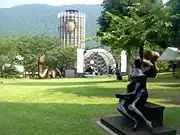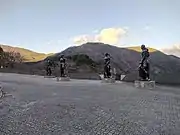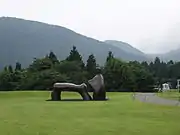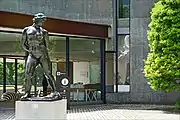Hakone Open-Air Museum
The Hakone Open-Air Museum (箱根 彫刻の森美術館, Hakone Choukoku no Mori Bijutsukan) is Japan's first open-air museum, opened in 1969 in Hakone, Ashigarashimo District, Kanagawa Prefecture. It holds collections of artworks by Picasso, Henry Moore, Taro Okamoto, Yasuo Mizui, Churyo Sato, Susumu Shingū, and many others, featuring over a thousand sculptures and works of art. The museum is affiliated with the Fujisankei Communications Group media conglomerate.
箱根 彫刻の森美術館 | |
 Hakone Open-Air Museum | |
Interactive fullscreen map | |
| Established | 1969 |
|---|---|
| Location | Hakone, Japan |
| Coordinates | 35°14′41″N 139°3′5″E |
| Type | Art museum |
| Website | hakone-oam |
The museum houses over 1,000 sculptures and features art by Constantin Brâncuși, Barbara Hepworth, Rokuzan Ogiwara, and Kōtarō Takamura.[1] About 120 sculptural works are on permanent display across the park.[2]
The museum is split into five indoor exhibitions and is best known for the Picasso Pavilion hall, which features around 300 of the Spanish artist's works. The museum also offers sculptures that children can play on and a naturally fed hot spring foot baths for guests.[3]
Gallery
Sculpture park and gardens
 Exterior park view
Exterior park view.jpg.webp) Joan Miró, 1972, Personnage
Joan Miró, 1972, Personnage Henry Moore, 1969–70, Reclining Figure: Arched Leg
Henry Moore, 1969–70, Reclining Figure: Arched Leg Exterior park view
Exterior park view.jpg.webp) Goto Ryoji, 1978, Intersecting Space Construction
Goto Ryoji, 1978, Intersecting Space Construction Aristide Maillol, 1905–06, Action Enchained
Aristide Maillol, 1905–06, Action Enchained
References
- Greco, Joann (25 February 2001). "A stroll through a forest of sculpture". St. Petersburg Times. Archived from the original on 1 May 2001. Retrieved 20 January 2010.
- "About the Hakone Open-Air Museum – Hakone Travel Guide | Planetyze". Planetyze. Retrieved 15 August 2017.
- "Open-Air Museum". Japan Deluxe Tours. Retrieved 21 May 2019.